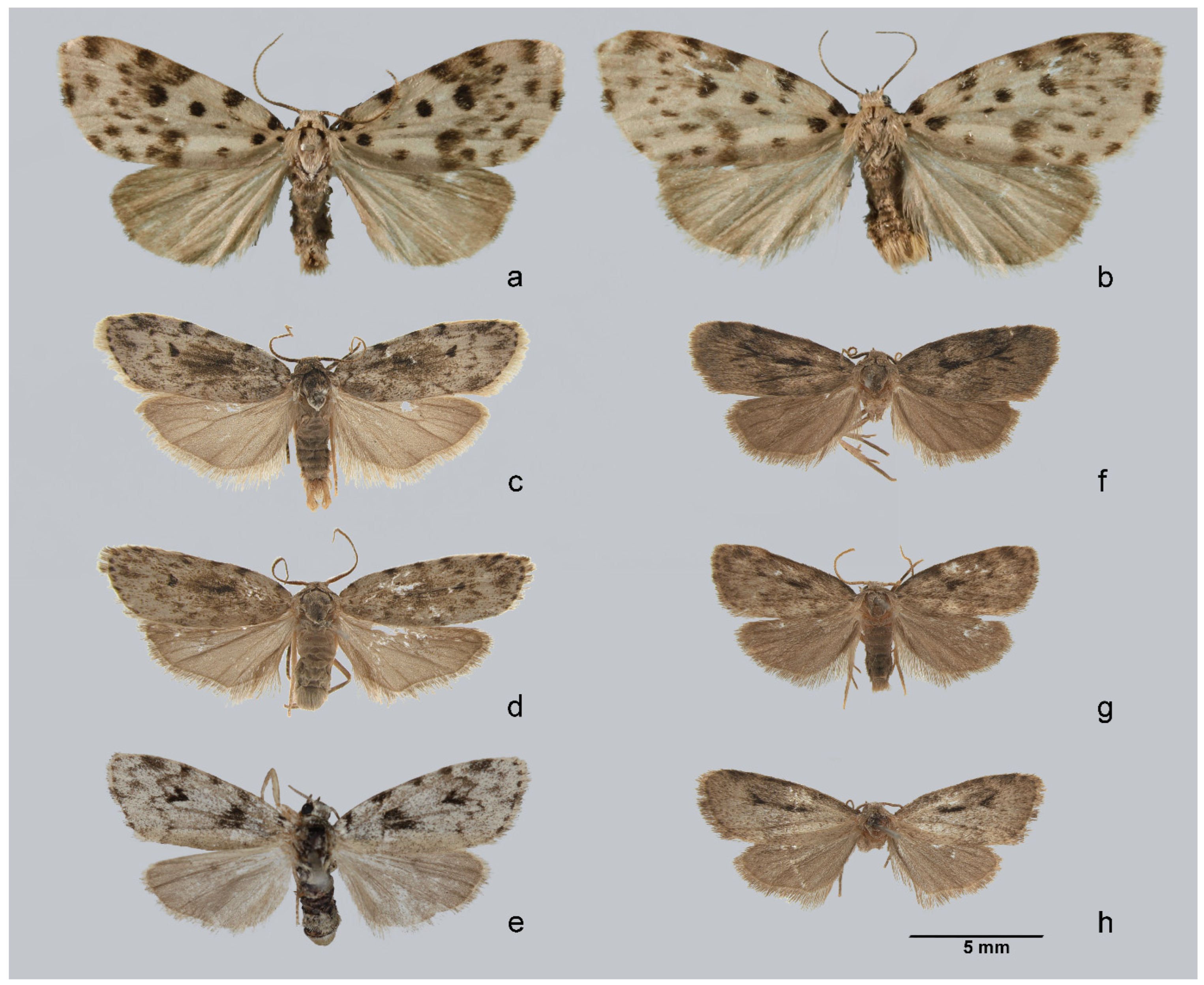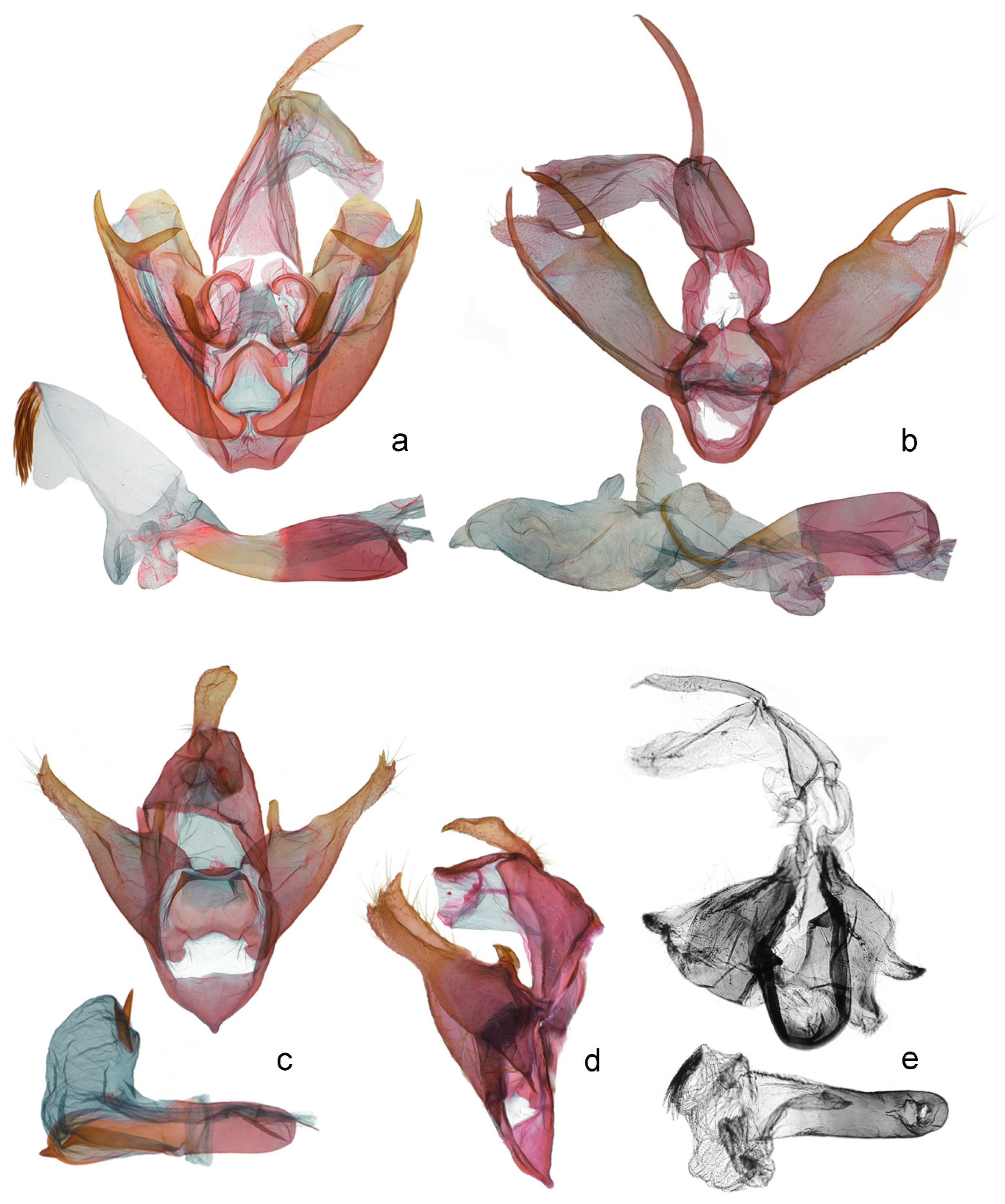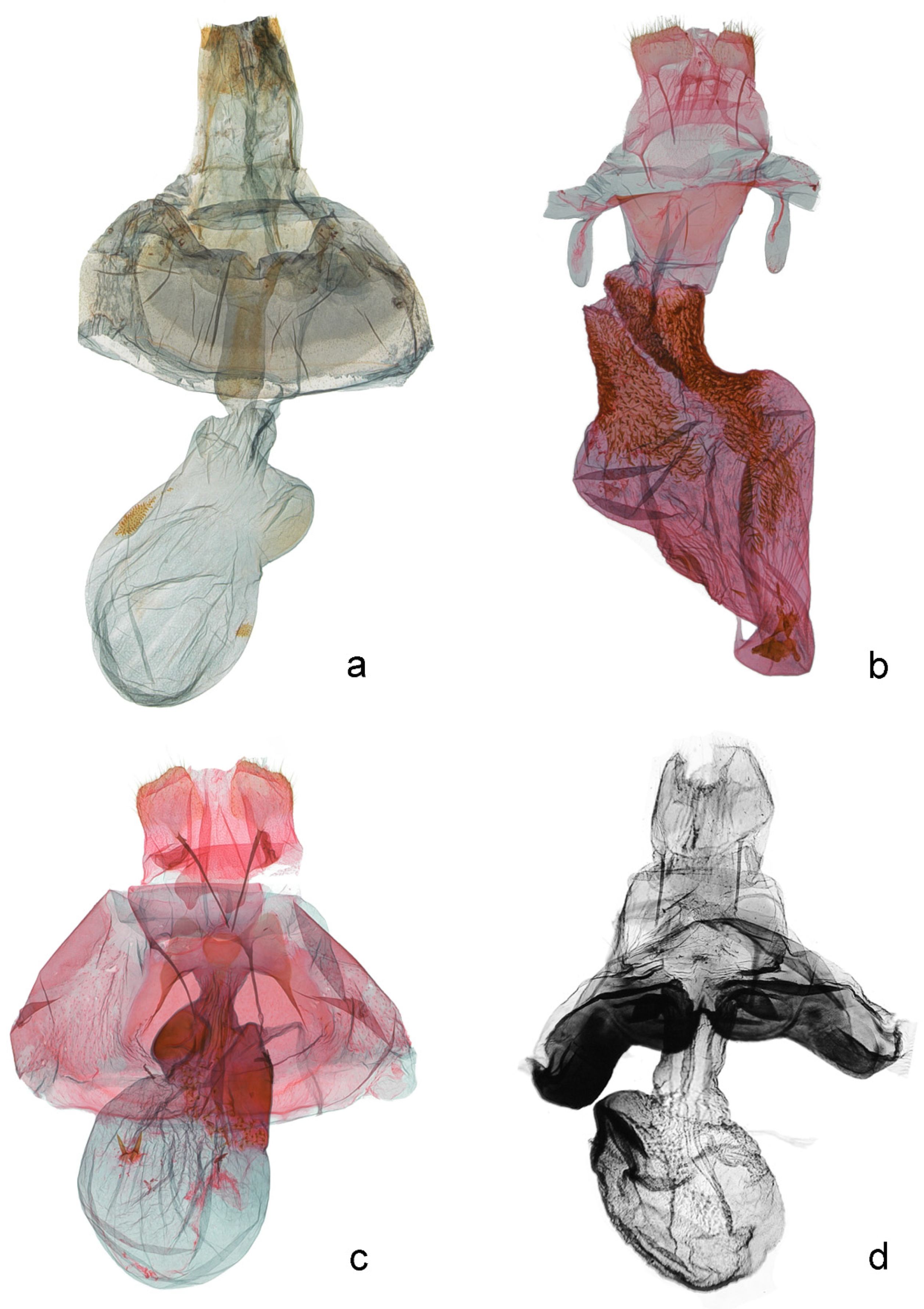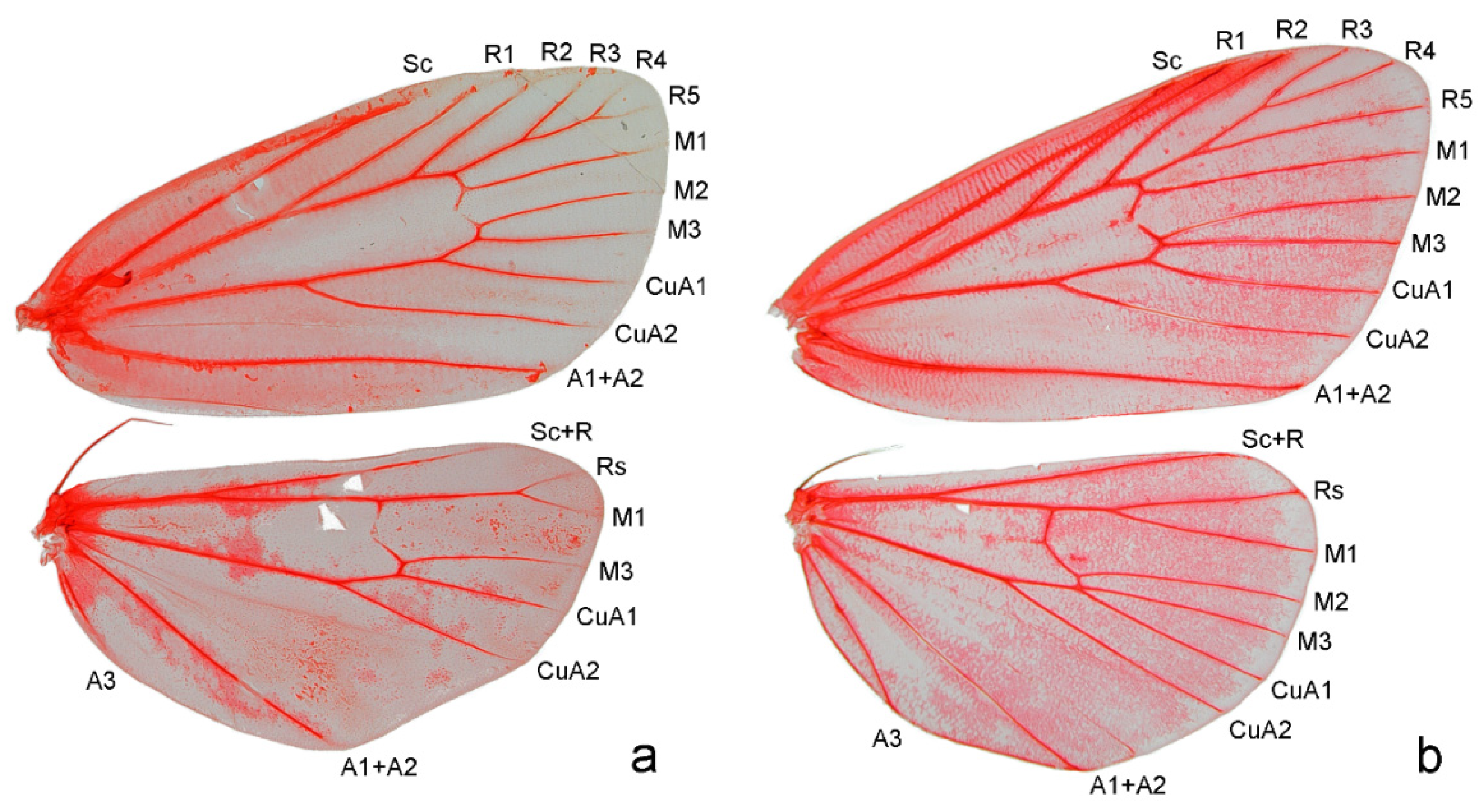Review of the Genus Aemene Walker, 1854 (Lepidoptera: Erebidae: Arctiinae) in Korea with Description of a New Species
Abstract
1. Introduction
2. Materials and Methods
3. Results
3.1. Systematic Accounts of the Genus Aemene Walker, 1854
3.2. Species Key to the Genus Aemene from Korea Based on Male Genitalia
- Uncus wide; valva tapering; aedeagus with apical spines… A. copaeninsulana sp. nov.
- -
- Uncus slender; valva wide; aedeagus without apical spine………………… 2
- 2.
- Costal margin of valva broadly rounded; saccus rectangular…………… A. altaica
- -
- Costal margin of valva not broadly rounded; saccus rounded………………… 3
- 3.
- Costal process of valva slender, almost half-length of uncus………… A. obscura
- -
- Costal process of valva stout, 1/3 length of uncus………………… A. shikatai
3.3. Species of Korean Aemene
3.3.1. Aemene altaica Lederer, 1855
3.3.2. Aemene obscura (Leech, 1889)
3.3.3. Aemene shikatai (Kishida, 2010)
3.3.4. Aemene copaeninsulana Bayarsaikhan and Bae, sp. nov.
4. Discussion
5. Conclusions
Author Contributions
Funding
Data Availability Statement
Acknowledgments
Conflicts of Interest
Abbreviations
| TL | Type locality |
| TS | Type species |
| CB | Chungcheongbuk-do |
| CN | Chungcheongnam-do |
| GB | Gyeongsangbuk-do |
| GG | Gyeonggi-do |
| GW | Gangwon-do |
| JB | Jeollabuk-do |
| JJ | Jeju-do |
| JN | Jeonlanam-do |
References
- Heppner, J.B. Faunal regions and the diversity of Lepidoptera. Trop. Lepid. 1991, 2 (Suppl. S1), 1–85. [Google Scholar]
- Scoble, M.J. The Lepidoptera. Form, function and diversity; Oxford University Press: New York, NY, USA, 1992; pp. 333–336. [Google Scholar]
- Scott, C.H.; Zaspel, J.M.; Chialvo, P.; Weller, S.J. A preliminary molecular phylogenetic assessment of the lichen moths (Lepidoptera: Erebidae: Arctiinae: Lithosiini) with comments on palatability and chemical sequestration. Syst. Entomol. 2014, 39, 286–303. [Google Scholar] [CrossRef]
- Wagner, D.L. Caterpillars of Eastern North America: A Guide to Identification and Natural History; Princeton University Press: Princeton, NJ, USA, 2005; pp. 1–512. [Google Scholar]
- Conner, W.E. Tiger Moths and Woolly Bears: Behavior, Ecology, and Evolution of the Arctiidae; Oxford University Press: New York, NY, USA, 2009; pp. 1–328. [Google Scholar]
- Holloway, J.D. The Moths of Borneo: Family Arctiidae, Syntominae, Euchromiinae, Arctiinae, Aganainae (to Noctuidae). Malay. Nat. J. 1988, 6, 1–101. [Google Scholar]
- Chialvo, C.H.S.; Chialvo, P.; Holland, J.D.; Anderson, T.J.; Breinholt, J.W.; Kawahara, A.Y.; Zhou, X.; Liu, S.; Zaspel, J.M. A phylogenomic analysis of lichen-feeding tiger moths uncovers evolutionary origins of host chemical sequestration. Mol. Phylogenet. Evol. 2018, 121, 23–24. [Google Scholar] [CrossRef]
- Sevastopulo, D.G. Early stages of Indian Lepidoptera, part XVIII. J. Bombay Nat. Hist. Soc. 1947, 47, 26–43. [Google Scholar]
- Robinson, G.S.; Ackery, P.R.; Kitching, I.J.; Beccaloni, G.W.; Hernándes, L.M. Hostplants of the Moths and Butterfly Caterpillars of the Oriental Region; United Selangor Press: Kuala Lumpur, Malaysia, 2001; pp. 1–722. [Google Scholar]
- Issiki, S.; Mutuura, A.; Yamamoto, Y.; Hattori, I. Early Stages of Japanese Moths in Colour; Hoikusha Publishing Co., Ltd.: Osaka, Japan, 1965; Volume 1. (In Japanese) [Google Scholar]
- Volynkin, A.V.; Černý, K.; Ivanova, M.S. Description of a new Aemene Walker, 1854 from North Thailand and Myanmar, with a checklist of the genus (Lepidoptera, Erebidae, Arctiinae). Zootaxa 2017, 4306, 444–450. [Google Scholar] [CrossRef]
- Černý, K.; Pinratana, A. Moths of Thailand. Arctiidae; Brothers of Staint Gabriel in Thailand: Bangkok, Thailand, 2009; Volume 6, 283p. [Google Scholar]
- Kirti, J.S.; Singh, N. Arctiid Moths if India; Nature Books India: New Delhi, India, 2016; Volume 2, 214p. [Google Scholar]
- Kishida, Y. Notes on Aemene altaica (Lederer, 1855) (Arctiidae) in Japan, with description of a new species. Jpn. Heterocerists’ J. 2018, 285, 233–256. [Google Scholar]
- Bucsek, K. Contribution to the knowledge of Lithosiini (Erebidae, Arctiinae) of central and northern Laos, part 3. Entomofauna Carpathica 2020, 32, 19–46. [Google Scholar]
- Volynkin, A.V. Three new species of the genus Aemene Walker (Lepidoptera: Erebidae: Arctiinae) from the Himalayas. Zootaxa 2021, 5068, 533–546. [Google Scholar] [CrossRef]
- Fang, C. Fauna Sinica Insecta (Lepidoptera: Arctiidae); Science Press: Beijing, China, 2000; Volume 19, 589p. [Google Scholar]
- Park, K.T. Lepidoptera (Arctiidae, Lymantriidae, Lasiocampidae, Sphingidae). Insecta Koreana 2000, (Suppl. 8), 9–82. [Google Scholar]
- Kishida, Y. Arctiidae. In The Standard of Moths in Japan II; Kishida, Y., Ed.; Gakken Education Publishing: Tokyo, Japan, 2011; pp. 148–167. [Google Scholar]
- Dubatolov, V.V. Subfamily Arctiinae. In Annotated Catalogue of the Insects of Russian Far East. Volume II. Lepidoptera; Lelei, A.S., Ed.; Dalnauka: Vladivostok, Russia, 2016; pp. 347–364. [Google Scholar]
- Bayarsaikhan, U.; Ju, Y.D.; Park, B.S.; Na, S.M.; Kim, J.W.; Lee, D.J.; Ko, J.H.; Bae, Y.S. Review of the subfamily Arctiinae (Lepidoptera: Erebidae) in South Korea, with a newly recorded genus. J. Asia-Pac. Biodivers. 2017, 10, 137–153. [Google Scholar] [CrossRef]
- Doi, H. A list of Heterocera of Korea. Kagakukanpo 1939, 81, 4–6. [Google Scholar]
- Bayarsaikhan, U.; Ju, Y.D.; Park, B.S.; Na, S.M.; Kim, J.W.; Lee, D.J.; Ko, J.H.; Bae, Y.S. Genus of Siccia (Lepidoptera: Erebidae: Arctiinae: Lithosiini) in Korea, with a new record. J. Asia-Pac. Biodivers. 2016, 9, 389–391. [Google Scholar] [CrossRef][Green Version]
- Choi, S.W.; Kim, S.S. Three new records of Arctiine moths (Lepidoptera: Erebidae; Arctiinae) from Korea. Anim. Syst. Evol. Divers. 2016, 32, 297–300. [Google Scholar] [CrossRef][Green Version]
- Walker, F. Catalogue of Lepidoptera Heterocera 1. In List of the Specimens of Lepidopterous Insects in the Collection of the British Museum List; Biodiversity Heritage Library: London, UK, 1854; Volume 2, pp. 279–581. [Google Scholar]
- Walker, F. Catalogue of Lepidoptera Heterocera 7. In List of the Specimens of Lepidopterous Insects in the Collection of the British Museum List; Biodiversity Heritage Library: London, UK, 1865; Volume 32, pp. 323–706. [Google Scholar]
- Felder, R. Lepidoptera. In Reise der österreichischen Fregatte Novara um die Erde in den Jahren 1857, 1858, 1859 unter den Behilfen des Commodore B. von Wüllerstorf-Urbair; Felder, R., Rogenhofer, A.F., Eds.; Zoologischer Theil; Wien, Kaiserlich-Königliche Hof- und Staatsdruckerei: Vienna, Austria, 1874; Volume 2, pp. 1–136. [Google Scholar]
- Hampson, G.F. Catalogue of the Arctiadae (Nilinae, Lithosinae) in the collection of the British Museum. Cat. Lepid. Phalaenae Br. Mus. 1900, 2, 389. [Google Scholar]
- Holloway, J.D. The Moths of Borneo: Family Arctiidae, Subfamily Lithosiinae. Malay. Nat. J. 2001, 7, 279–486. [Google Scholar]
- Lederer, J. Weiterer beitrag zur Schmetterlinge-fauna de Altaigerbirges in Sibirien. Verhandlungen Zool.-Bot. Vereins Wien 1855, 5, 97–120. [Google Scholar]
- Butler, A.G. Descriptions of new Species of Heterocera from Japan. (1). Sphinges and Bombyces. Ann. Gazine Nat. Hist. Incl. Zool. Bot. Geol. 1877, 20, 393–404. [Google Scholar]
- Bryk, F. Zur Kenntnis der Großschmetterlinge von Korea. II. Macrofrenatae. Ark. Zool. 1948, 41, 1–125. [Google Scholar]
- Kim, C.W.; Nam, S.H.; Lee, S.M. Illustrated Flora & Fauna of Korea; Ministry of Education: Seoul, Korea, 1982; Volume 26, 919p. [Google Scholar]
- The Entomological Society of Korea & Korean Society of Applied Entomology (ESK & KSAE). Check list of Insects from Korea; KonKuk University Press: Seoul, Korea, 1994; 752p. [Google Scholar]
- Paek, M.K.; Hwang, J.M.; Jung, K.S.; Kim, T.W.; Kim, M.C.; Lee, Y.J.; Cho, Y.B.; Park, S.W.; Lee, H.S.; Ku, D.S.; et al. Checklist of Korean Insects; Nature & Ecology: Seoul, Korea, 2010; 598p. [Google Scholar]
- Bae, Y.S.; Bayarsaikhan, U.; Park, B.S. Insect Fauna of Korea. In Arthropoda: Insecta: Lepidoptera: Noctuoidea: Arctiidae; The National Institute of Biological Resources: Incheon, Korea, 2013; 147p. [Google Scholar]
- National Institute of Biological Resources (NIBR). National Species list of Korea; Designzip: Incheon, Korea, 2019; 988p. [Google Scholar]
- Korean Society of Applied Entomology & The Entomological Society of Korea (KSAE & ESK). Check List of Insects from Korea; Paper and Pencil: Daegu, Korea, 2021; 1055p. [Google Scholar]
- Leech, J.H. On the Lepidoptera of Japan and Corea,—Part II. Heterocera, Sect. I. In Proceedings of the Scientific Meetings of the Zoological Society of London 1888 [1889]; Forgotten Books: London, UK, 2018; pp. 580–655. [Google Scholar]
- Kishida, Y. Descriptions of new species and new subspecies of Japanese Macrolepidoptera (1). Tinea 2010, 21, 57–69. [Google Scholar]
- Heppner, J.B.; Inoue, H. Lepidoptera of Taiwan. Checklist; Association for Tropical Lepidoptera/Scientific Publishers: Gainesville, FL, USA, 1992; Volume 1, Part 2; 276p. [Google Scholar]
- Bucsek, K. Several species of genus Eugoa Walker, 1858 (Arctiinae, Lithosiini) from Indonesia and India. Entomofauna Carpathica 2016, 28, 69–84. [Google Scholar]




Publisher’s Note: MDPI stays neutral with regard to jurisdictional claims in published maps and institutional affiliations. |
© 2022 by the authors. Licensee MDPI, Basel, Switzerland. This article is an open access article distributed under the terms and conditions of the Creative Commons Attribution (CC BY) license (https://creativecommons.org/licenses/by/4.0/).
Share and Cite
Bayarsaikhan, U.; Cha, Y.-B.; Ko, J.-H.; Kwon, H.W.; Bae, Y.-S. Review of the Genus Aemene Walker, 1854 (Lepidoptera: Erebidae: Arctiinae) in Korea with Description of a New Species. Forests 2022, 13, 1748. https://doi.org/10.3390/f13111748
Bayarsaikhan U, Cha Y-B, Ko J-H, Kwon HW, Bae Y-S. Review of the Genus Aemene Walker, 1854 (Lepidoptera: Erebidae: Arctiinae) in Korea with Description of a New Species. Forests. 2022; 13(11):1748. https://doi.org/10.3390/f13111748
Chicago/Turabian StyleBayarsaikhan, Ulziijargal, Yeong-Bin Cha, Jae-Ho Ko, Hyung Wook Kwon, and Yang-Seop Bae. 2022. "Review of the Genus Aemene Walker, 1854 (Lepidoptera: Erebidae: Arctiinae) in Korea with Description of a New Species" Forests 13, no. 11: 1748. https://doi.org/10.3390/f13111748
APA StyleBayarsaikhan, U., Cha, Y.-B., Ko, J.-H., Kwon, H. W., & Bae, Y.-S. (2022). Review of the Genus Aemene Walker, 1854 (Lepidoptera: Erebidae: Arctiinae) in Korea with Description of a New Species. Forests, 13(11), 1748. https://doi.org/10.3390/f13111748





